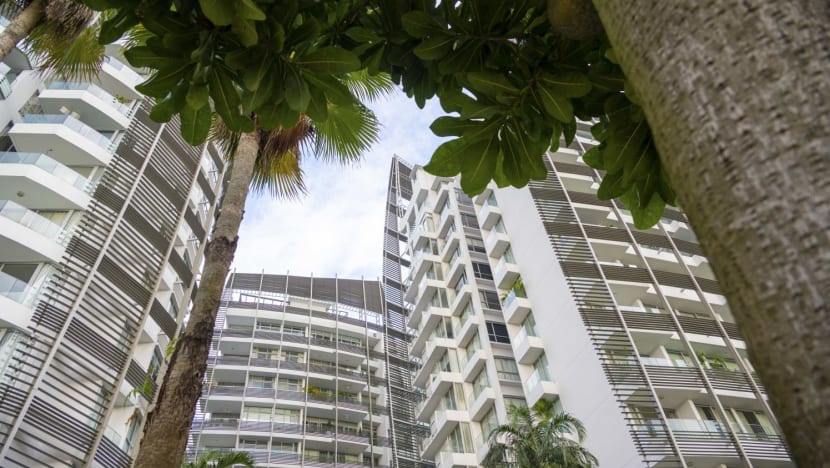Private home prices in Singapore fall 0.2% in second quarter, first dip in 3 years

File photo of private residential property in Singapore. (Photo: iStock)
SINGAPORE: Private housing prices fell slightly by 0.2 per cent in the second quarter of 2023, according to real estate statistics released by the Urban Redevelopment Authority (URA) on Friday (Jul 28).
This is the first time that private home prices have declined since the first quarter of 2020, when prices fell 1 per cent during the onset of COVID-19, said Ms Christine Sun, senior vice president of research and analytics at OrangeTee & Tie.
The URA price index for private property is now at 194.4, down from 194.8 in the preceding quarter.
Prices show signs of moderation and stabilisation, said Ms Sun.
The dip is slightly less than the flash estimates released earlier this month, which indicated a 0.4 per cent fall in prices.
According to the latest data, prices of non-landed properties – or condominiums and apartments – fell by 0.6 per cent in the second quarter, a reversal from the 2.6 per cent increase in the previous quarter.
By region, prices of non-landed properties in the Rest of Central Region (RCR) fell the most, by 2.5 per cent. Such homes in the Core Central Region (CCR) also slipped by 0.1 per cent.
But prices of non-landed properties in the Outside Central Region (OCR) continued to climb, up 1.2 per cent in the second quarter. This is a slower increase than the first quarter's 1.9 per cent.
Prices of landed properties increased by 1.1 per cent, moderating from a 5.9 per cent increase in the first quarter.
Ms Sun said that the slower price growth may be attributed to property cooling measures implemented in September 2022 and April 2023, which raised the additional buyer's stamp duty (ABSD) for some buyers and affected borrowing ability.
"Some buyers continue to face high borrowing costs as interest rates remain elevated. Sellers are also facing more pressure as supply gradually builds up with more private home completions," she said.
More new private homes were launched and sold in the second quarter, compared with the preceding quarter. Of the 2,374 uncompleted units launched, excluding executive condominiums (ECs), developers sold 2,127.
This is substantially higher than the 1,312 units launched and 1,256 units sold in the first quarter.
There were 2,976 transactions in the second quarter, compared with 2,622 transactions in the preceding quarter. Subsales accounted for about 5.3 per cent of all transactions, down from 5.9 per cent in the first quarter.
RISE IN RENTS SLOWING
Rentals of private residential properties increased by 2.8 per cent in the second quarter, lower than the 7.2 per cent increase in the previous quarter.
Non-landed property rents went up by 2.3 per cent, while rents for landed properties increased 6.7 per cent in the second quarter – both slowing from the preceding quarter.
Rental momentum has eased across all market segments, said URA, with rentals rising at a slower pace in all regions.
Mr Eugene Lim, ERA Realty Network's key executive officer, said that there are two possible reasons for the slowing rental growth and drop in transactions.
The first is that there was a significant volume of condominiums completed in 2023. Secondly, there was a "mismatch" in the expectations of landlords and tenants, which has led to fewer tenants accepting high rents.
Mr Lee Sze Teck, senior director of data analytics at Huttons, said a quiet job market could be one of the reasons for the slowing rental growth.
MOST BUYERS SINGAPOREAN
Mr Lee noted that about 80 per cent of private property purchases in the second quarter were made by Singaporeans, while 15.9 per cent of the transactions were by permanent residents, and foreigners made up 4.1 per cent.
Following cooling measures in April that increased the ABSD for foreigners to 60 per cent, the number of non-landed residential homes bought by foreigners reduced significantly in June, he said.
Of the 27 purchases by foreigners in June, 12 were from the US, two were from China, another two were from Switzerland, and one each from India, Norway and the UK. The remaining eight were unspecified.
"Of the five countries which are given the same tax treatment as Singaporeans, the USA has always been among the top purchasers of residential properties in Singapore," said Mr Lee.
"Hence it is not surprising that they have dislodged the Chinese from the number one position."
PRIVATE HOUSING SUPPLY
A total of 4,401 private residential units, including ECs, were completed in the second quarter, more than the 3,785 units completed in the preceding quarter.
The number of units completed in the second quarter was about 83 per cent more than the average of around 2,400 units completed per quarter in 2022.
Projects completed in the last quarter include Riverfront Residences with 1,472 units, Affinity At Serangoon, which has 1,052 units, and The Woodleigh Residences, adding 667 units.
Based on the expected completion dates reported by developers, 12,306 units will be completed in the second half of 2023 and about 40,200 units are expected to be completed between 2023 and 2025.
Overall, private home prices increased about 3.1 per cent in the first half of 2023, and analysts expect prices to continue rising at a slower pace this year. Some analysts estimate a more restrained increase of 3 per cent to 6 per cent, compared with price hikes in the last two years.
"With the possibility of a technical recession looming in the minds of home buyers, private home prices are expected to stabilise, with increases being more subdued," said Mr Leonard Tay, head of research at Knight Frank Singapore.
















